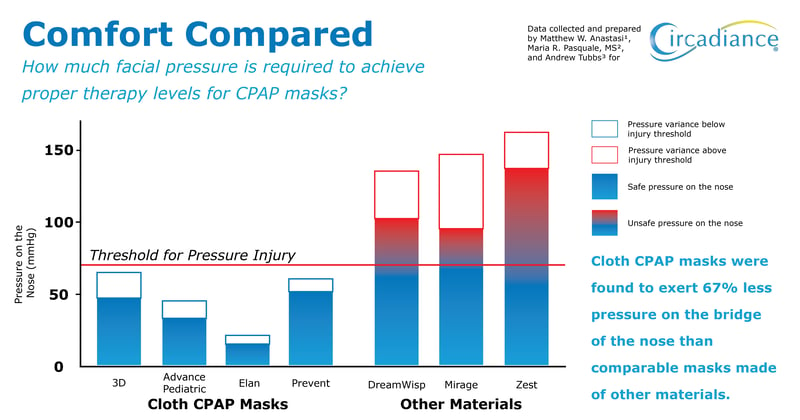The following blog is an abstract put together to demonstrate the pressure differences between traditional and cloth CPAP masks.
Introduction: Pressure between a CPAP mask and the skin is a significant contributor to irritation and pressure ulcers, an area of localized soft tissue ischemic necrosis caused by prolonged pressure over bony prominences that exceeds supra capillary pressure (70 mmHg). We hypothesized that cloth masks would exert a lower nasal bridge pressure than traditional mask products constructed of silicone and plastic.
Methods: We evaluated the pressure exerted by seven types of nasal masks in three trials onto the nasal bridge of two healthy adult volunteers while they received 10 cm H₂O of CPAP. Four commercially available cloth masks (SleepWeaver® 3D, SleepWeaver® Advance Pediatric, SleepWeaver® Élan, and SleepWeaver® Prevent, Circadiance®, LLC) were tested as were three traditional masks constructed primarily of silicone and plastic (DreamWisp™, Philips Respironics, Inc.; Mirage™, ResMed; Zest™, Fisher & Paykel Healthcare). Pressure was detected using a texsens®-g low-pressure sensor force measuring device. Pressure data from each 30-second trial were summarized as the median value after confirming that pressure did not vary by time (one-way ANOVA, p = 0.7393). Median values were then compared across trials, subjects, and masks using one-way ANOVAs and student’s t-tests.
Results: After confirming that pressure did not vary by trial (one-way ANOVA, p=0.4585) or subject (t-test, p=0.0938), pressure data was summarized by mask. On average, cloth masks exerted 37.0 (17.7) mmHg of nasal bridge pressure, although there was significant variation across masks (one-way ANOVA, p < 0.0001). Conversely, traditional masks averaged 112 (38.5) mmHg of nasal bridge pressure without significant variation across masks (one-way ANOVA, p=0.1291). Cloth masks averaged 75.26 mmHg less pressure than traditional masks (p < 0.0001), a difference of 67%.
Conclusion: The data supports the hypothesis that pressure from cloth masks on the bridge of the nose are significantly lower than a sample of traditional masks with similar shape and style, and the null hypothesis was rejected. Furthermore, the average cloth mask was below the threshold for capillary closing, in contrast to the average traditional mask. Therefore, for CPAP users with predicted or existing skin sensitivity, comfort, and/or compliance concerns, cloth masks should be considered as a first choice in mask selection.
—Matthew W. Anastasi¹; Maria R. Pasquale, MS²; Andrew Tubbs³
Support: Circadiance, LLC
¹Limina Sleep Consulting, LLC, Pittsburgh, PA; ²Novel Electronics, Inc., St. Paul, MN; ³University of Arizona, Tucson, AZ






